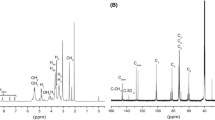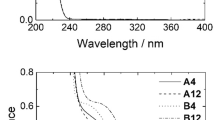Abstract
The binding constants for the inclusion complexes formed between heptakis-(2,6-di-O-methyl)-β-cyclodextrin (MβCD) and mono-(3,6-anhydro)-β-cyclodextrin (AβCD) with a set of suitably selected organic guests, were measured by means of polarimetry. Measurements were carried out at various pH values in order to ensure the correct protonation state for ionizable guests. Experimental data suggest that the binding properties of MβCD may be rationalized considering the less polar and more hydrophobic character of the cavity, although similar variations in conformational/dynamic behaviour occur as for native βCD. On the other hand, AβCD shows some similarities with αCD, due to the significant distortion in the shape and reduction in size of the macro cycle, as confirmed also by simple computational models.




Similar content being viewed by others
Notes
The K value for 4 found by us is much lower than the one previously measured calorimetrically by Bertrand (380 M−1, see ref. 16), but at a different pH value.
Noticeably, guests 4–10 constitute on the whole a representative set of nitrobenzene derivatives. One would expect data could be subjected to some sort of LFER (such as Hammett or Taft) correlation analysis. However, these systems are so strictly affected by the occurrence of specific (hydrogen bond, for instance) interactions that this approach is matter-of-factly unsuitable. In particular, on considering p-nitroanilines 6–10, we have to assume that possible variations of electronic effects for the aromatic moiety are almost negligible.
A pictorial representation of a typical trend for experimental data can be found in ref. [48].
References
Easton, C.J., Lincoln, S.F.: Chiral discrimination by modified cyclodextrins. Chem. Soc. Rev 25, 163–170 (1996)
Connors, K.A.: The stability of cyclodextrin complexes in solution. Chem. Rev. 97, 1325–1357 (1997)
Rekharsky, M.V., Inoue, Y.: Complexation thermodynamics of cyclodextrins. Chem. Rev. 98, 1875–1917 (1998) and (references therein)
Szejtli, J.: Introduction and general overview of cyclodextrin. Chem. Rev. 98, 1743–1753 (1998)
Takahashi, K.: Organic reactions mediated by cyclodextrins. Chem. Rev. 98, 2013−2033 (1998)
Fakayode, S.O., Lowry, M., Fletcher, K.A., Huang, X.D., Powe, A.M., Warner, I.M.: Cyclodextrins host-guest chemistry in analytical and environmental chemistry. Curr. Anal. Chem. 3, 171–181 (2007)
Schurig, V., Wistuba, D.: Recent innovations in enantiomer separation by electrochromatography utilizing modified cyclodextrins as stationary phases. Electrophoresis 20, 2313–2328 (1999)
D’Anna, F., Lo Meo, P., Riela, S., Noto, R.: Cyclodextrins: heterocycic molecules able to perform chiral recognition (part I). Targets Heterocycl. Chem. 9, 1–38 (2005)
D’Anna, F., Lo Meo, P., Riela, S., Noto, R.: Cyclodextrins: heterocycic molecules able to perform chiral recognition (part II). Targets Heterocycl. Chem. 10, 91–113 (2006)
Vyas, A., Saraf, S., Saraf, S.J.: Cyclodextrin based novel drug delivery systems. J. Incl. Phenom. Macrocycl. Chem. 62, 23–42 (2008)
Harada, A., Takashima, Y., Yamaguchi, H.: Cyclodextrin-based supramolecular polymers. Chem. Soc. Rev. 38, 875–882 (2009)
Tabushi, I., Kiyosuke, Y., Sugimoto, T., Yamamura, K.J.J.: Approach to the aspects of driving force of inclusion by alpha-cyclodextrin. J. Am. Chem. Soc. 100, 916–919 (1978)
Liu, L., Guo, Q.X.J.: The driving forces in the inclusion complexation of cyclodextrins. J. Incl. Phenom. Macrocycl. Chem. 42, 1–14 (2002)
Schmidtchen, F.P.: The anatomy of the energetics of molecular recognition by calorimetry: Chiral discrimination of camphor by alpha-cyclodextrin. Chem. Eur. J. 8, 3522–3529 (2002)
Lo Meo, P., D’Anna, F., Riela, S., Gruttadauria, M., Noto, R.: Spectrophotometric study on the thermodynamics of binding of alpha- and beta-cyclodextrin towards some p-nitrobenzene derivatives. Org. Biomol. Chem. 1, 1584–1590 (2003)
Matsui, Y., Mochida, K.: Binding forces contributing to the association of cyclodextrin with alcohol in an aqueous Solution. Bull. Chem. Soc. Jpn. 52, 2808–2814 (1979)
D’Anna, F., Lo Meo, P., Riela, S., Gruttadauria, M., Noto, R.: Spectrophotometric determinations of binding constants between cyclodextrins and aromatic nitrogen substrates at various pH values. Tetrahedron 57, 6823–6827 (2001)
Lo Meo, P., D’Anna, F., Riela, S., Gruttadauria, M., Noto, R.: Spectrophotometric determination of binding constants between some aminocyclodextrins and nitrobenzene derivatives at various pH values. Tetrahedron 58, 6039–6045 (2002)
Ribeiro, J.P., Bacchi, S., Dell’Anna, G., Morando, M., Cañada, F.J., Cozzi, F., Jimenez-Barbero, J.: A combined NMR, computational, and HPLC study of the inclusion of aromatic and fluoroaromatic compounds in cyclodextrins as a model for studying carbohydrate–aromatic interactions. Eur. J. Org. Chem. 5891–5898 (2008)
Lo Meo, P., D’Anna, F., Gruttadauria, M., Riela, S., Noto, R.: Thermodynamics of binding between alpha- and beta-cyclodextrins and some p-nitro-aniline derivatives: reconsidering the enthalpy-entropy compensation effect. Tetrahedron 60, 9099–9111 (2004)
Dodziuk, H.J.: Rigidity versus flexibility. A review of experimental and theoretical studies pertaining to the cyclodextrin nonrigidity. J. Mol. Struct. 614, 33–45 (2002)
Kozár, T., Venanzi, C.A.: Reconsidering the conformational flexibility of beta-cyclodextrin. J. Mol. Struct. (Theochem) 395–396, 451–468 (1997)
Mayer, B., Marconi, G., Klein, C., Kohler, G., Wolschann, P.J.: Structural analysis of host-guest systems. Methyl-substituted phenols in beta-cyclodextrin. Inclusion Phenom. Mol. Recognit. Chem. 29, 79–93 (1997) and (references therein)
Raffaini, G., Ganazzoli, F.: Hydration and flexibility of alpha-, beta-, gamma- and delta-cyclodextrin: a molecular dynamics study. Chem. Phys. 333, 128–134 (2007)
Usha, M.G., Wittebort, R.J.J.: Structural and dynamic studies of the hydrate exchangeable hydrogens, and included molecules in beta-cyclodextrins and gamma-cyclodextrins by powder and single crystal deuterium magnetic-resonance. J. Am. Chem. Soc. 114, 1541–1548 (1992)
Inoue, Y., Okuda, T., Chûjô, R.: A high-resolution CP-Mass C-13-NMR study of solid-state cyclomalohexaose inclusion-complexes chemical-shifts and structure of the host cyclomaltohexaose. Carbohydr. Res. 141, 179–190 (1985)
Yamamoto, Y., Onda, M., Takahashi, Y., Inoue, Y., Chûjô, R.: Determinatin of the host-guest geometry in the inclusion complexes of cyclomalto-oligosaccharides with para-nitrophenol in solution. Carbohydr. Res. 182, 41–52 (1988)
Inoue, Y., Kuan, F.H., Takahashi, Y., Chûjô, R.: CP-MAS C-13-NMR study of cyclomaltohexaose and cyclomatohep. Carbohydr. Res. 135, C12–C16 (1985)
Inoue, Y., Kuan, F.H., Chûjô, R.: CP-MAS C-13-NMR study of some solid state inclusion complexes of cyclomalooligosaccharides with parasubstituted benzenes. Carbohydr. Res. 159, 1–10 (1987)
Dodziuk, H., Nowiński, K.: Structure of cyclodextrins and their complexes. 2. Do cyclodextrins have a rigid truncated-cone structure? J. Mol. Struct. (Theochem) 110, 61–68 (1994)
Rekharsky, M.V., Yamamura, H., Kawai, M., Inoue, I.J.: Complexation and chiral recognition thermodynamics of gamma-cyclodextrin with N-acetyl- and N-carbobenzyloxy-dipeptides possessing two aromatic rings. Org. Chem. 68, 5228–5235 (2003)
Lo Meo, P., D’Anna, F., Riela, S., Gruttadauria, M., Noto, R.: Binding equilibria between beta-cyclodextrin and p-nitro-aniline derivatives: the first systematic study in mixed water-methanol solvent systems. Tetrahedron 65, 2037–2042 (2009)
Khan, A.R., Forgo, P., Stine, K.J., D’Souza, V.T.: Methods for selective modifications of cyclodextrins. Chem. Rev. 98, 1977–1996 (1998)
Lo Meo, P., D’Anna, F., Riela, S., Gruttadauria, M., Noto, R.: Binding properties of mono-(6-deoxy-6-amino)-beta-cyclodextrin towards p-nitroaniline derivatives: a polarimetric study. Tetrahedron 65, 10413–10417 (2009)
Cramer, F., Mackensen, G., Sensse, K.: On ring compounds. XX. ORD-spectra and conformation of the glucose ring in cyclodextrins. Chem. Ber. 102, 494–508 (1969)
Fujita, K., Yamamura, H., Imoto, T., Tabushi, I.: Preparation of a 3A,6A-anhydro-beta-cyclodextrin and its taka amylolysis. Chem. Lett. 17, 543–546 (1988)
Bertrand, G.L., Faulkner, J.R., Han, S.M., Armstrong, D.W.J.: Substituent effects on the binding of phenols to cyclodextrins in aqueous solution. J. Phys. Chem. 93, 6863–6867 (1989)
Fujita, K., Okabe, Y., Ohta, K., Yamamura, H., Tahara, T., Nogami, Y., Koga, T.: Dependence of guest-binding ability on cavity shape of deformed cyclodextrins. Tetrahedron Lett. 37, 1825–1828 (1996)
de Vries, E.J.C., Caira, M.R.: A structural and thermal investigation of the inclusion of parabens in heptakis(2,6-di-O-methyl)cyclomaltohepta. Carbohyd. Res. 343, 2433–2438 (2008)
Song, L.X., Wang, H.M., Xu, P., Yang, Y., Zhang, Z.Q.: Experimental and Theoretical Studies on the Inclusion Complexation of Syringic Acid with alpha-, beta-, gamma- and heptakis(2,6-di-O-methyl)-beta-cyclodextrin. Chem. Pharm. Bull. 56, 468–474 (2008)
Bortolus, P., Marconi, G., Monti, S., Mayer, B.J.: Chiral discrimination of camphorquinone enantiomers by cyclodextrins: a spectroscopic and photophysical study. Phys. Chem. A 106, 1686–1694 (2002)
Gelb, R.I., Schwartz, L.M., Laufer, D.A.: Adamantan-1-ylamine and adamantan-1-ylamine hydrochloride complexes with cycloamyloses. J. Chem. Soc., Perkin Trans. 2, 15–21 (1984)
Eftink, M.R., Andy, M.L., Bystrom, K., Perlmutter, H.D., Kristol, D.S.J.: Cyclodextrin inclusion complexes—studies of the variation in the size of alicyclic guests. J. Am. Chem. Soc. 111, 6765–6772 (1989)
Carranzana, J., Jover, A., Meijide, F., Soto, V.H., Vazquez Tato, J.J.: Complexation of adamantyl compounds by beta-cyclodextrin and monoaminoderivatives. J. Phys. Chem. B 109, 9719–9726 (2005)
Lü, T.-X., Zhand, D.-B., Dong, S.-J., Study on dynamic repeatability, linearity and performance improvement of a force transduce. J. Chem. Soc., Faraday Trans. 2. 85, 1439–1445 (1989)
Bonora, G.M., Fornasier, R., Scrimin, P., Tonellato, U.: Induced circular dichroism of conjugated cyclohexenones included in native or modified cyclomaltooligosaccharides. J. Chem. Soc., Perkin Trans.2, 367–369 (1985)
Tee, O.S., Mazza, C., Du, X.-X.: Chain length effects in the cleavage of aryl esters by cyclodextrins. Different transition states for m- and pnitrophenyl alkanoates. J. Org. Chem. 55, 3603–3609 (1990)
Lo Meo, P., D’Anna, F., Riela, S., Gruttadauria, M., Noto, R.: Polarimetry as a useful tool for the determination of binding constants between cyclodextrins and organic guest molecules. Tetrahedron Lett. 47, 9099–9102 (2006)
Lo Meo, P., D’Anna, F., Riela, S., Gruttadauria, M., Noto, R.: Host-guest interactions involving cyclodextrins: useful complementary insights achieved by polarimetry. Tetrahedron 63, 9163–9171 (2007)
Rees, D.A.: Conformational analysis of polysaccharides. Part V. The characterization of linkage conformations (chain conformations) by optical rotation at a single wavelength. Evidence for distortion of cyclohexa-amylose in aqueous solution. Optical rotation and the amylose conformation J. Chem. Soc. 877–884 (1970)
Rees, D.A., Thorn, D.: Polysaccharide conformation. Part 10.1 solvent and temperature effects on the optical rotation and conformation of model carbohydrates. J. Chem. Soc., Perkin Trans. 2, 191–201 (1977)
Fisher, E.: Ueber die glucoside der alkohole. Ber. Chem. Ges. 26, 2400–2412 (1893)
Riiber, C.N.: Lösungsvolumen und refraktionskonstante des alpha- und beta-Methylglykosids. (IV.) mitteilung über mutarotation. Ber. Chem. Ges. 57, 1797–1799 (1924)
Reeves, R.E.J.: Methyl 2,6-Dimethyl-α-d-glucopyranoside. Am. Chem. Soc. 70, 259–260 (1948)
Foster, A.B., Overend, W.G., Vaughan, G.: Structure and reactivity of anhydro-sugars. Part III. An interpretation of some reactions of 3:6-anhydro-d-hexoses. J. Chem. Soc. 3625–3629 (1954)
Inoue, Y., Takahashi, Y., Chûjô, R.: The host-guest orientation in the inclusion complex of hexakis(2,3,6-tri-O-methyl)cyclomaltohexaose with p-nitrophenol in aqueous solution. Carbohydr. Res. 144, C9–C11 (1985)
Acknowledgment
University of Palermo (funds for selected research topics) is gratefully acknowledged for financial support.
Author information
Authors and Affiliations
Corresponding author
Rights and permissions
About this article
Cite this article
Meo, P.L., D’Anna, F., Riela, S. et al. Binding properties of heptakis-(2,6-di-O-methyl)-β-cyclodextrin and mono-(3,6-anhydro)-β-cyclodextrin: a polarimetric study. J Incl Phenom Macrocycl Chem 71, 121–127 (2011). https://doi.org/10.1007/s10847-010-9915-0
Received:
Accepted:
Published:
Issue Date:
DOI: https://doi.org/10.1007/s10847-010-9915-0




